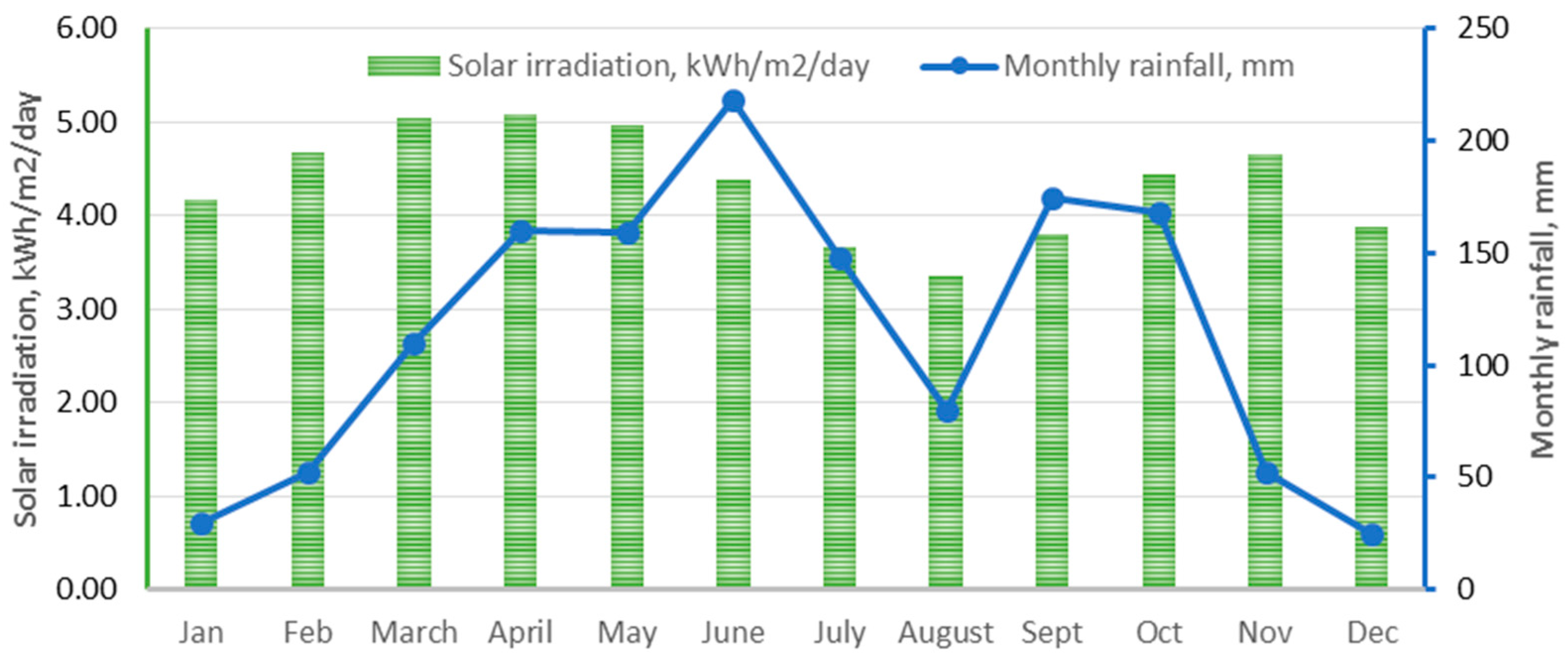Reliability and Degradation of Solar PV Modules—Case Study of 19-Year-Old Polycrystalline Modules in Ghana
Abstract
:1. Introduction
2. Materials and Methods
2.1. Site Description and Climate
2.2. Description of Installation
2.3. Inspection and Measurements
2.4. Calculations and Data Analysis
- is a dimensionless temperature coefficient of Isc (default value is 0)
- is dimensionless temperature coefficient of Voc (default value is −0.004)
- a is dimensionless irradiance correction factor (default value is 0.06) and
- Rs is series resistance (Ω) (default value is 0)
3. Results and Discussion
3.1. Visual and Physical Inspection
3.2. Performance Measurements (I-V Curve)
3.2.1. Peak Power
3.2.2. Short-Circuit Current
3.2.3. Open-Circuit Voltage
3.2.4. Fill Factor
3.3. Thermal Imaging
3.4. Accounting for Power Loss
3.5. General Discussion
4. Concluding Remarks
- The physical condition of the modules was good, with no major visually observable defects on the front glass, back sheets, wires/connectors, junction box, frame and metallization. Some bubble on front side and minor discolouration at the edge of some cells were however observed upon magnification of images acquired.
- During the period of exposure (19 years), the median decline recorded in the performance parameters of the modules, compared with reference values were, respectively: Peak Power (Pnom)-24%, Short Circuit Current (Isc)-7.9%, Open Circuit Voltage (Voc)-4.1% and Fill Factor (FF)-14.3%.
- On an annual basis, the median of the decline in performance parameters were: Pnom-1.3%, Isc-0.4%, Voc-0.2% and FF-0.8%.
- The module had a warranty of 10 years, with a tolerance of ±10%. At the median annual power degradation rate of 1.3%, the module has met and exceeded warranty expectations, even if the lower end of the tolerance was ignored.
- The reduction in nominal power is dominated by reduction in fill factor and short circuit current.
Acknowledgments
Author Contributions
Conflicts of Interest
Appendix A
| Module ID | T mod, °C | G, W/m2 | Isc [A] | Voc [V] | Impp [A] | Umpp [V] | P [W] | FF |
|---|---|---|---|---|---|---|---|---|
| PWX1 | 56.70 | 970.00 | 2.73 | 18.33 | 2.18 | 11.86 | 25.80 | 0.51 |
| PWX2 | 58.80 | 937.00 | 2.69 | 18.14 | 2.25 | 13.34 | 30.00 | 0.61 |
| PWX3 | 58.90 | 941.00 | 2.67 | 18.02 | 2.15 | 13.53 | 29.10 | 0.60 |
| PWX4 | 58.90 | 949.00 | 2.72 | 18.10 | 2.25 | 12.83 | 28.80 | 0.59 |
| PWX5 | 54.10 | 997.00 | 2.83 | 18.73 | 2.39 | 13.88 | 33.20 | 0.63 |
| PWX6 | 50.10 | 1014.00 | 2.76 | 18.84 | 2.26 | 13.91 | 31.40 | 0.60 |
| PWX7 | 51.10 | 958.00 | 2.79 | 18.73 | 2.30 | 14.01 | 32.20 | 0.61 |
| PWX8 | 51.40 | 958.00 | 2.81 | 18.73 | 2.37 | 13.61 | 32.20 | 0.61 |
| PWX9 | 57.40 | 960.00 | 2.74 | 18.27 | 2.22 | 13.74 | 30.40 | 0.61 |
| PWX10 | 51.50 | 883.00 | 2.59 | 18.73 | 2.14 | 14.01 | 30.00 | 0.62 |
| PWX11 | 57.30 | 964.00 | 2.76 | 18.42 | 2.25 | 13.67 | 30.70 | 0.60 |
| PWX12 | 49.10 | 917.00 | 2.65 | 19.03 | 2.06 | 14.87 | 30.60 | 0.61 |
| PWX13 | 47.80 | 962.00 | 2.71 | 18.90 | 2.22 | 14.28 | 31.70 | 0.62 |
| PWX14 | 55.40 | 1020.00 | 2.81 | 18.19 | 2.38 | 13.46 | 32.00 | 0.63 |
References
- IEA. Projected Costs of Generating Electricity 2015 Edition; IEA: Paris, France, 2015. [Google Scholar]
- IEA. Technology Roadmap: Solar Photovoltaic Energy 2014 edition; OECD/IEA: Paris, France, 2014. [Google Scholar]
- IEA. World Energy Outlook; OECD/IEA: Paris, France, 2013. [Google Scholar]
- IRENA. Africa 2030: Roadmap for a Renewable Energy Future; IRENA: Masdar City, United Arab Emirates, 2015. [Google Scholar]
- IRENA. Solar PV in Africa: Costs and Markets; IRENA: Masdar City, United Arab Emirates, 2016. [Google Scholar]
- REN21. ECOWAS Renewable Energy and Energy Efficiency Status Report; ECREEE/UNIDO/REN21: Paris, France, 2014. [Google Scholar]
- REN21. Renewables 2015 Global Status Report; REN21 Secretariat: Paris, France, 2015. [Google Scholar]
- REN21. Renewables 2016 Global Status Report; REN21 Secretariat: Paris, France, 2016. [Google Scholar]
- Fraunhofer ISE. Photovoltaics Report; Fraunhofer ISE: Freiburg, Germany, 2015. [Google Scholar]
- NREL. Best Research Cell Efficiencies; NREL: Golden, CO, USA, 2016. [Google Scholar]
- Yoshikawa, K.; Kawasaki, H.; Yoshida, W.; Irie, T.; Konishi, K.; Nakano, K.; Uto, T.; Adachi, D.; Kanematsu, M.; Uzu, H.; et al. Silicon heterojunction solar cell with interdigitated back contacts for a photoconversion efficiency over 26%. Nat. Energy 2017, 2, 17032. [Google Scholar] [CrossRef]
- Solar Cell Efficiency Detailed Balance. Available online: http://www.pveducation.org/pvcdrom/detailed-balance (accessed on 16 May 2017).
- Shockley, W.; Queisser, H.J. Detailed Balance Limit of Efficiency of p-n Junction Solar Cells. J. Appl. Phys. 1961, 32, 510. [Google Scholar] [CrossRef]
- ITRPV/VDMA. International Technology Roadmap for Photovoltaic 2015 Results; ITRPV/VDMA: Frankfurt, Germany, 2016. [Google Scholar]
- Yang, G. Life Cycle Reliability Engineering; John Wiley & Sons: Hoboken, NJ, USA, 2007. [Google Scholar]
- ReliaSoft Corporation. About Reliability Engineering. 2016. Available online: http://www.weibull.com/basics/reliability.htm. (accessed on 18 May 2017).
- Verma, A.K.; Ajit, S.; Karanki, D.R. Reliability and Safety Engineering; Springer: London, UK, 2016. [Google Scholar]
- Jordan, D.C.; Kurtz, S.R. Photovoltaic Degradation Rates—an Analytical Review. Prog. Photovolt. Res. Appl. 2013, 21, 12–29. [Google Scholar] [CrossRef]
- EnergySage Inc. What to Know About a Solar Panel Warranty; EnergySage Inc.: Boston, MA, USA, 2015. [Google Scholar]
- REC Solar. 25-year Linear Power Output Warranty. Available online: http://www.recgroup.com/sites/default/files/documents/rec_fact_sheet_warranty_web_en_20130719.pdf (accessed on 16 May 2017).
- King, D.L.; Quintana, M.A.; Kratochvil, J.A.; Ellibee, D.E.; Hansen, B.R. Photovoltaic module performance and durability following long-term field exposure. AIP Conf. Proc. 1999, 462, 565–571. [Google Scholar]
- Srinivasan, S. Solar photovoltaics: Oligopsony, non-market decision-making and the paradoxical persistence of unprofitability. Int. J. Green Econ. 2013, 7, 116–147. [Google Scholar] [CrossRef]
- GTM Research. Rest in Peace: The List of Deceased Solar Companies. Available online: http://www.greentechmedia.com/articles/read/Rest-in-Peace-The-List-of-Deceased-Solar-Companies?utm_source=Daily&utm_medium=Headline&utm_campaign=GTMDaily (accessed 18 May 2017).
- CivicSolar Inc. Canadian Solar Warranty Insurance. Available online: http://investors.canadiansolar.com/phoenix.zhtml?c=196781&p=irol-newsArticle&ID=1695334 (accessed on 18 May 2017).
- CSUN. 25-Year Insurance Backed Warranty. Available online: http://www.csun-solar.com/fileadmin/dateiablage/documents/PowerGuard_CSUN_2014_Flyer.pdf (accessed on 18 May 2017).
- Trina Solar. 25 Year Insurance Backed Warranty. Available online: https://es-media-prod.s3.amazonaws.com/media/u/bad/9e9/d9b/4a377fac554a5266604e7b20285d4e78/TrinaSolar_Warranty.pdf (accessed on 18 May 2017).
- Canadian Solar (USA) Inc. PV Module Warranty and Warranty Insurance Comparisons: A Cornerstone of Bankability. Available online: http://www.solarsouthwestflorida.com/wp-content/uploads/2012/01/PV-Module-Warranty-and-Warranty-Insurance-Comparisons-White-Paper-Sept.-2011.pdf (accessed on 18 May 2017).
- IEC. Crystalline Silicon Terrestrial Photovoltaic (PV) Modules—Design Qualification and Type Approval. Available online: https://webstore.iec.ch/publication/4928 (accessed on 18 May 2017).
- IEC. Thin-Film Terrestrial Photovoltaic (PV) Modules—Design Qualification and Type Approval; IEC: Geneva, Switzerland, 2008. [Google Scholar]
- Osterwald, C.R.; McMahon, T.J. History of Accelerated and Qualification Testing of Terrestrial Photovoltaic Modules: A Literature Review. Prog. Photovolt. Res. Appl. 2009, 17, 11–33. [Google Scholar] [CrossRef]
- Zielnik, A.F.; Dumbleton, D.P. Photovoltaic Module Weather Durability & Reliability—Will my module last outdoors? Available online: https://us.sunpower.com/sites/sunpower/files/media-library/white-papers/wp-atlas-25-plus-photovoltaic-module-weather-durability-reliability.pdf (accessed on 16 May 2017).
- IEA. Review of Failures of Photovoltaic Modules; OECD/IEA: Paris, France, 2014. [Google Scholar]
- Fraunhofer ISE. Photovoltaics Report; Fraunhofer ISE: Freiburg, Germany, 2016. [Google Scholar]
- ITRPV/VDMA. International Technology Roadmap for Photovoltaic; ITRPV/VDMA: Frankfurt, Germany, 2015. [Google Scholar]
- Rudolph, D.; Olibet, S.; Hoornstra, J.; Weeber, A.; Cabrera, E.; Carr, A.; Koppes, M.; Kopecek, R. Replacement of silver in silicon solar cell metallization pastes containing a highly reactive glass frit: Is it possible? Energy Proced. 2013, 43, 44–53. [Google Scholar] [CrossRef]
- Lorenzo, E.; Zilles, R.; Moretón, R.; Gómez, T.; de Olcoz, A.M. Performance analysis of a 7-kW crystalline silicon generator after 17 years of operation in Madrid. Prog. Photovolt. Res. Appl. 2014, 22, 1273–1279. [Google Scholar] [CrossRef]
- Bandou, F.; Arab, A.H.; Belkaid, M.S.; Logerais, P.-O.; Riou, O.; Charki, A. Evaluation performance of photovoltaic modules after a long time operation in Saharan environment. Int. J. Hydrog. Energy 2015, 40, 13839–13848. [Google Scholar] [CrossRef]
- Ndiaye, A.; Kébé, C.M.F.; Charki, A.; Ndiaye, P.A.; Sambou, V.; Kobi, A. Degradation evaluation of crystalline-silicon photovoltaic modules after a few operation years in a tropical environment. Sol. Energy 2014, 103, 70–77. [Google Scholar] [CrossRef]
- Quintana, M.A.; King, D.L.; McMahon, T.J.; Osterwald, C.R. Commonly Observed Degradation in Field-Aged Photovoltaic Modules. Proceedings of Conference Record of the Twenty-Ninth IEEE Photovoltaic Specialists Conference, New Orleans, LA, USA, 19–24 May 2002; pp. 1436–1439. [Google Scholar]
- Skoczek, A. Long-term performance of photovoltaic modules. Available online: http://www.solar-academy.com/menuis/longtermperformanceofpvsystems032725.pdf (accessed on 16 May 2017).
- Skoczek, A.; Sample, T.; Dunlop, E.D. The results of performance measurements of field-aged crystalline silicon photovoltaic modules. Prog. Photovolt. Res. Appl. 2009, 17, 227–240. [Google Scholar] [CrossRef]
- Kahoul, N.; Houabes, M.; Sadok, M. Assessing the early degradation of photovoltaic modules performance in the saharan region. Energy Convers. Manag. 2014, 82, 320–326. [Google Scholar] [CrossRef]
- Ferrara, C.; Philipp, D. Why Do PV Modules Fail? Energy Proced. 2012, 15, 379–387. [Google Scholar] [CrossRef]
- Jordan, D.C.; Wohlgemuth, J.H.; Kurtz, S.R. Technology and Climate Trends in PV Module Degradation. Proceedings of 27th European Photovoltaic Solar Energy Conference and Exhibition, Frankfurt, Germany, 24–28 September 2012. [Google Scholar]
- Phinikarides, A.; Kindyni, N.; Makrides, G.; Georghiou, G.E. Review of photovoltaic degradation rate methodologies. Renew. Sustain. Energy Rev. 2014, 40, 143–152. [Google Scholar] [CrossRef]
- Peel, M.C.; Finlayson, B.L.; Mcmahon, T.A. Updated world map of the köppen-geiger climate classification. Hydrol. Earth Syst. Sci. Discuss. 2007, 4, 439–473. [Google Scholar] [CrossRef]
- FAO. Ghana—Country Pasture/Forage Resource Profiles. Available online: http://www.fao.org/ag/agp/agpc/doc/counprof/ghana/Ghana.htm#3.%20CLIMATE%20AND%20AGRO-ECOLOGICAL%20ZONES (accessed on 21 November 2016).
- All-India Survey of Photovoltaic Module Degradation: 2013. Available online: http://www.ncpre.iitb.ac.in/research/pdf/All_India_Survey_of_Photovoltaic_Module_Degradation_2013.pdf (accessed on 16 May 2017).
- RETScreen International. RETScreen Clean Energy Project Analysis Software (Version 4.1) Climate Database. Available online: http://www.nrcan.gc.ca/energy/software-tools/7465 (accessed on 18 May 2017).
- Nkrumah, F.; Klutse, N.A.B.; Adukpo, D.C.; Owusu, K.; Quagraine, K.A.; Owusu, A.; Gutowski, W. Rainfall variability over ghana: Model versus rain gauge observation. Int. J. Geosci. 2014, 5, 11. [Google Scholar] [CrossRef]
- PVsyst SA; Version 5.74; PVSyst Photovoltaic Software: Satigny, Switzerland, 2012.
- Field Applications for I-V Curve Tracers. Available online: http://solarprofessional.com/articles/design-installation/field-applications-for-i-v-curve-tracers (accessed on 16 May 2017).
- Current-Voltage Translation Procedure for PV Generators in the German 1,000 Roofs-Programme. Available online: http://citeseerx.ist.psu.edu/viewdoc/download?doi=10.1.1.475.4370&rep=rep1&type=pdf (accessed on 16 May 2017).
- Zaaiman, W. Solar Irradiance and Photovoltaic Measurements from Solar Radiation to PV Arrays. Proceedings of AFRETEP 3rd Regional Workshop, Cape Town, South Africa, 20–24 February 2012. [Google Scholar]
- IEC. IEC 60891:2009 Photovoltaic devices—Procedures for Temperature and Irradiance Corrections to Measured I-V Characteristics; IEC: Geneva, Switzerland, 2009. [Google Scholar]
- Outdoor PV Module Degradation of Current-Voltage Parameters. 2012. Available online: http://www.nrel.gov/docs/fy12osti/53713.pdf (accessed on 16 May 2017).
- Tsuno, Y.; Hishikawa, Y.; Kurokawa, K. Modeling I-V Curves of PV Modules Using Interpolation/Extrapolation. Sol. Energy Mater. Sol. Cell. 2009, 93, 1070–1073. [Google Scholar] [CrossRef]
- Marion, B. A method for modeling the current–voltage curve of a PV module for outdoor conditions. Prog. Photovolt. Res. Appl. 2002, 10, 205–214. [Google Scholar] [CrossRef]
- Anderson, J.A. Photovoltaic Translation Equations: A New Approach; NREL: Golden, CO, USA, 1996. [Google Scholar]
- Jordan, D.C.; Kurtz, S.R.; VanSant, K.; Newmiller, J. Compendium of photovoltaic degradation rates. Prog. Photovolt. Res. Appl. 2016, 24, 978–989. [Google Scholar] [CrossRef]
- Effect of parasitic Resistances- Series Resistance. Available online: http://www.pveducation.org/pvcdrom/series-resistance (accessed on 5 December 2016).
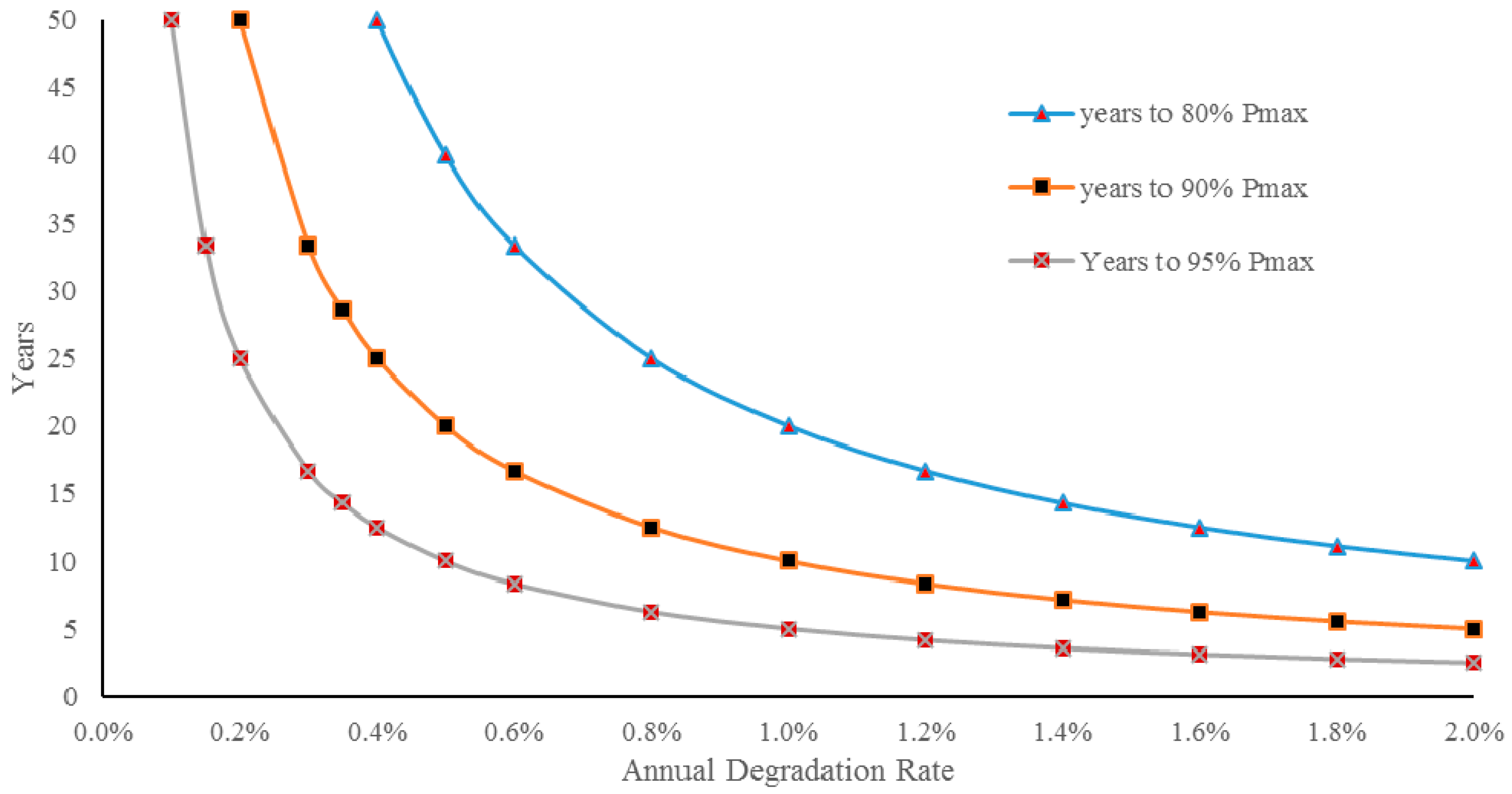
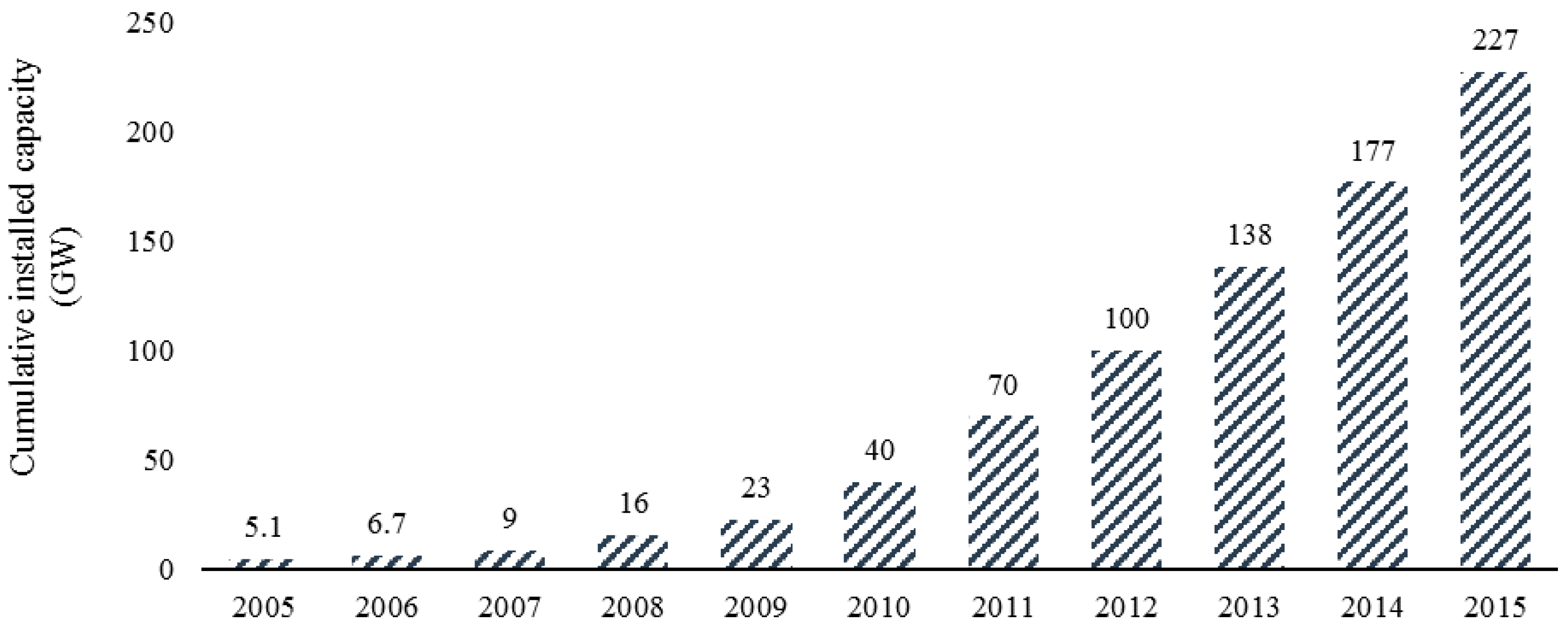
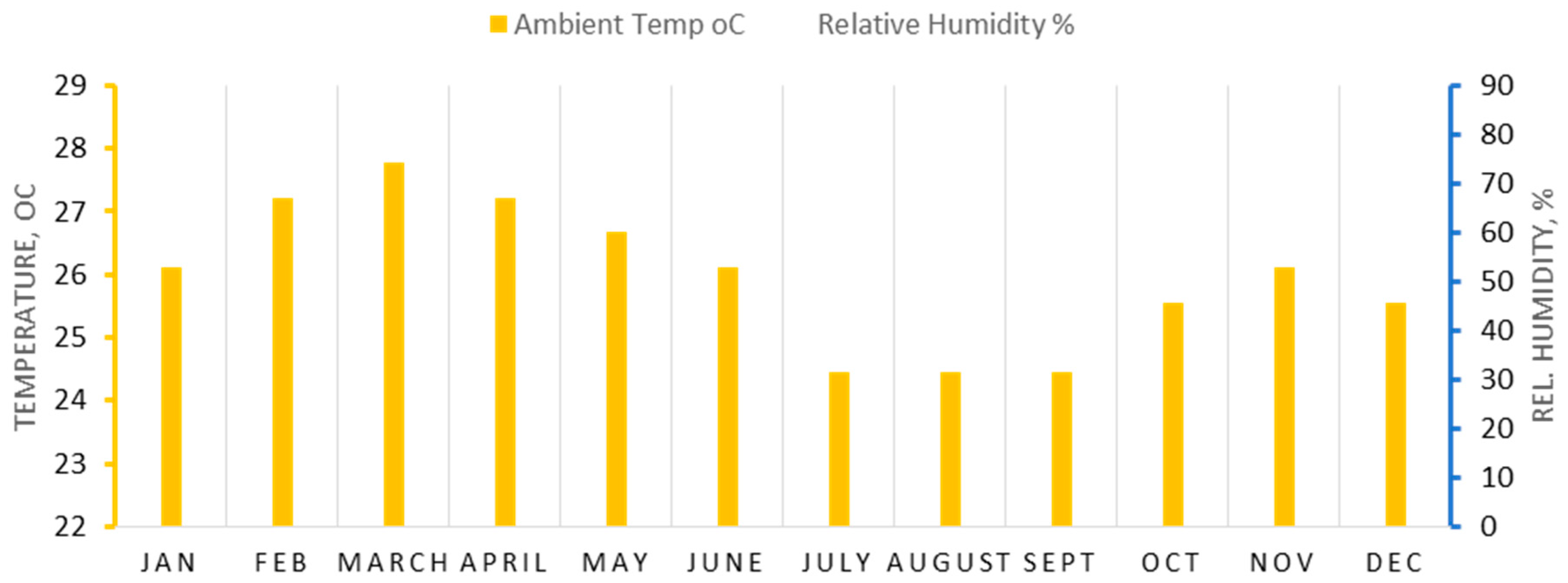
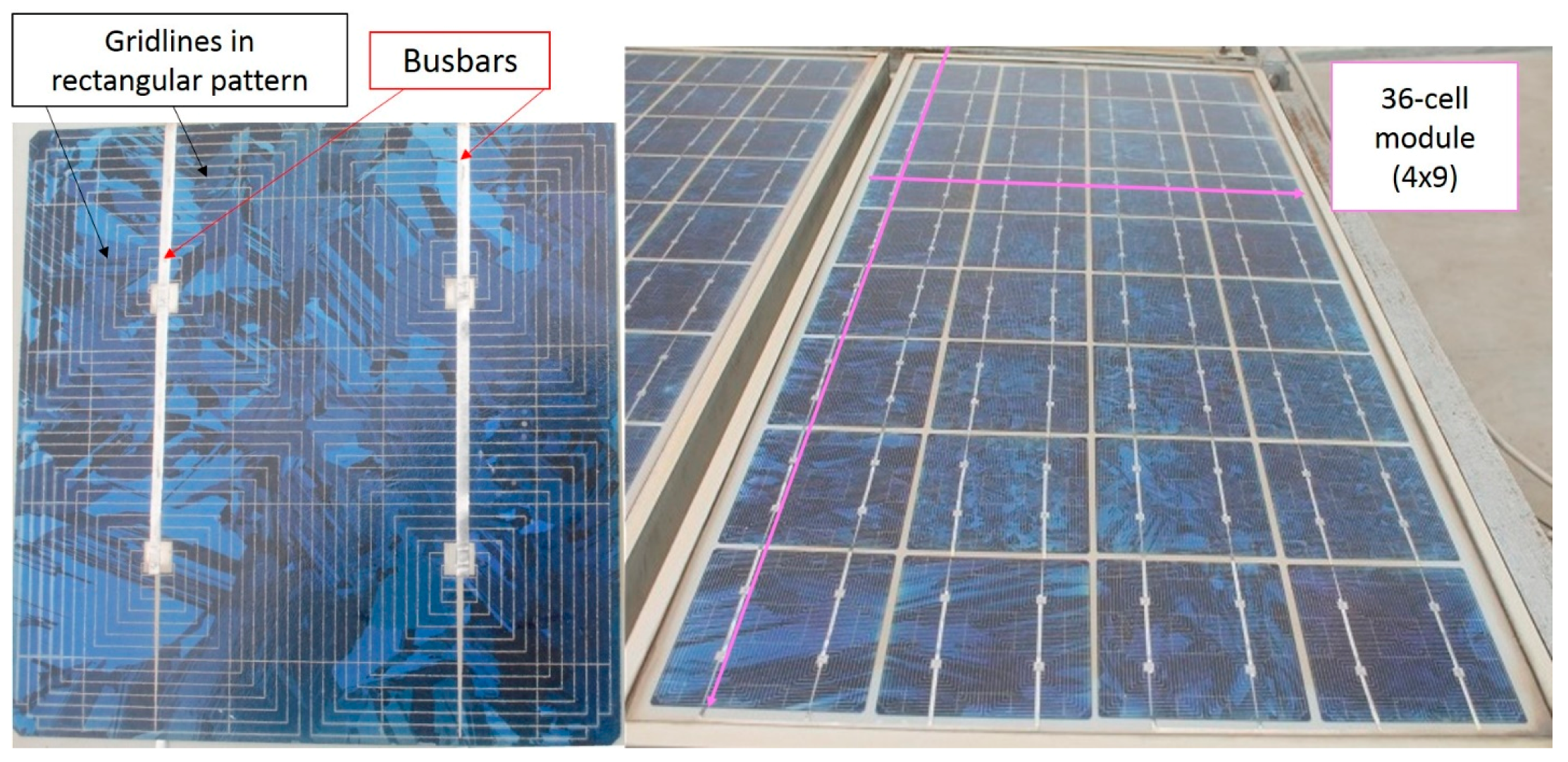
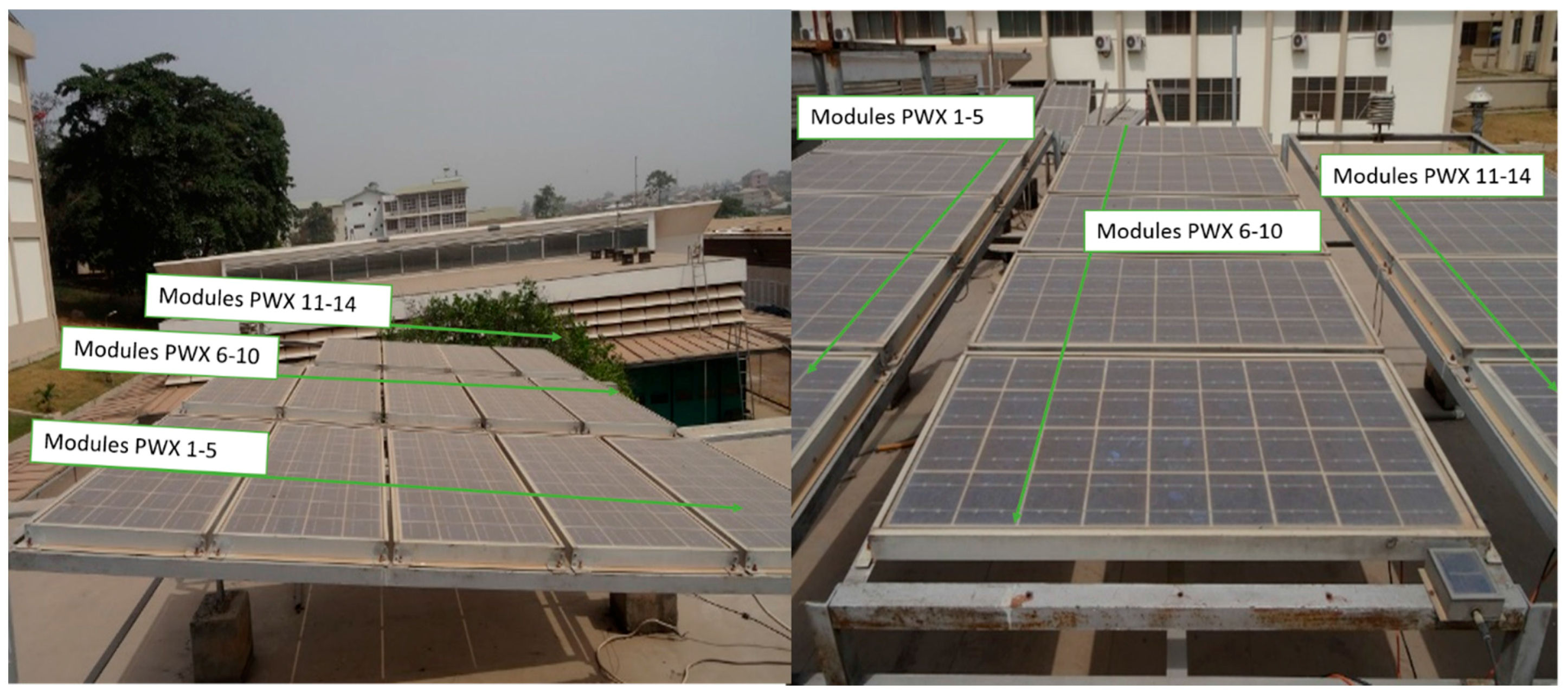
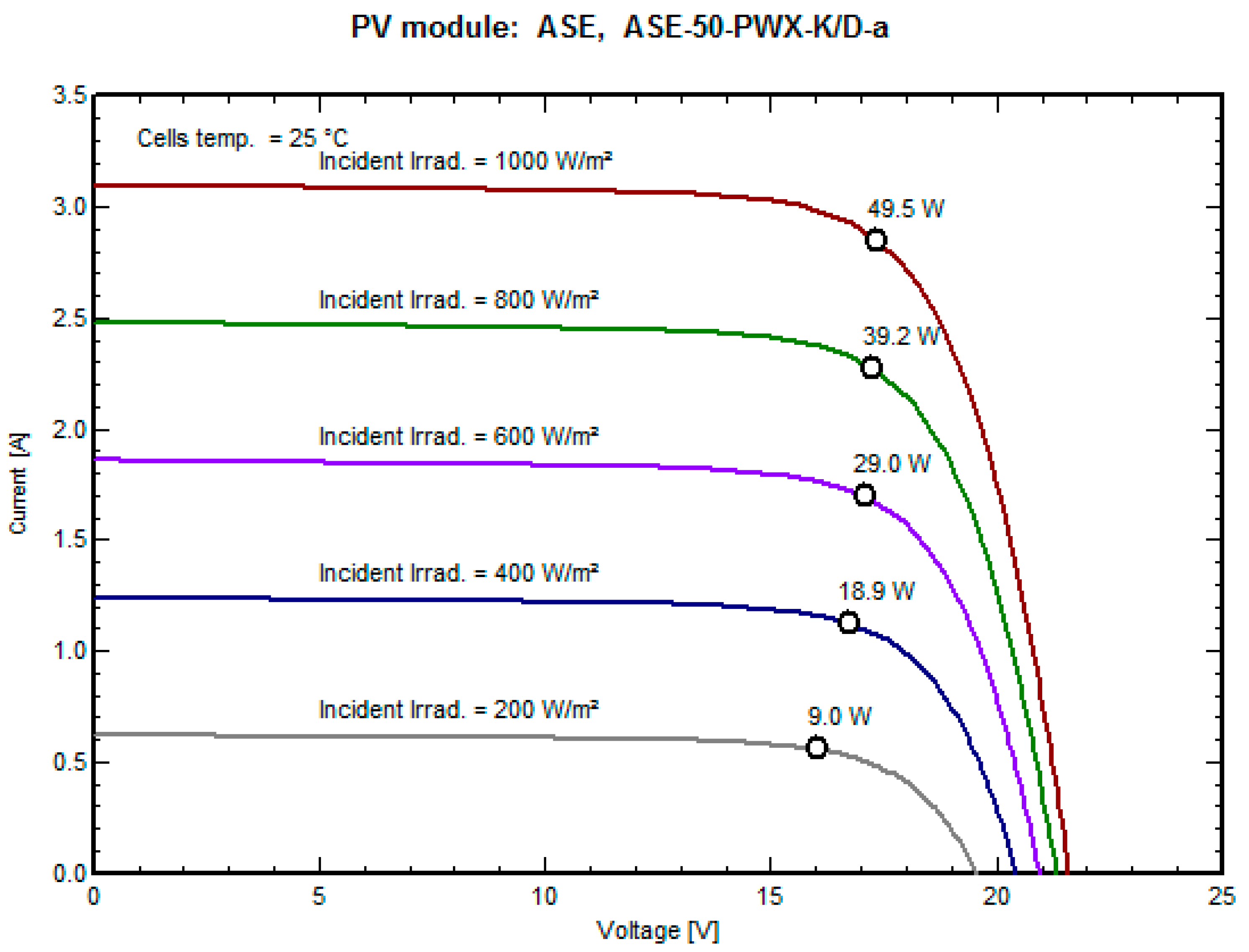
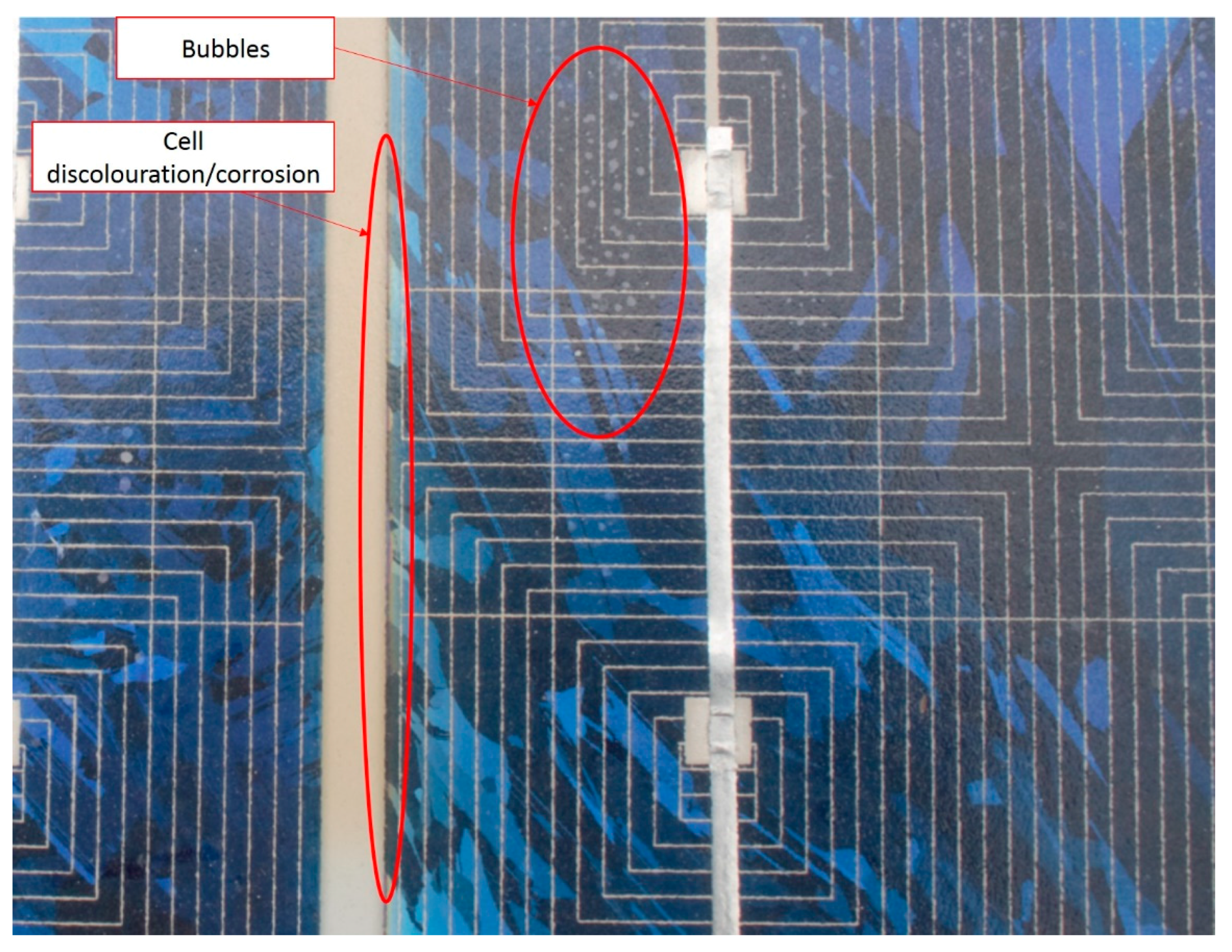

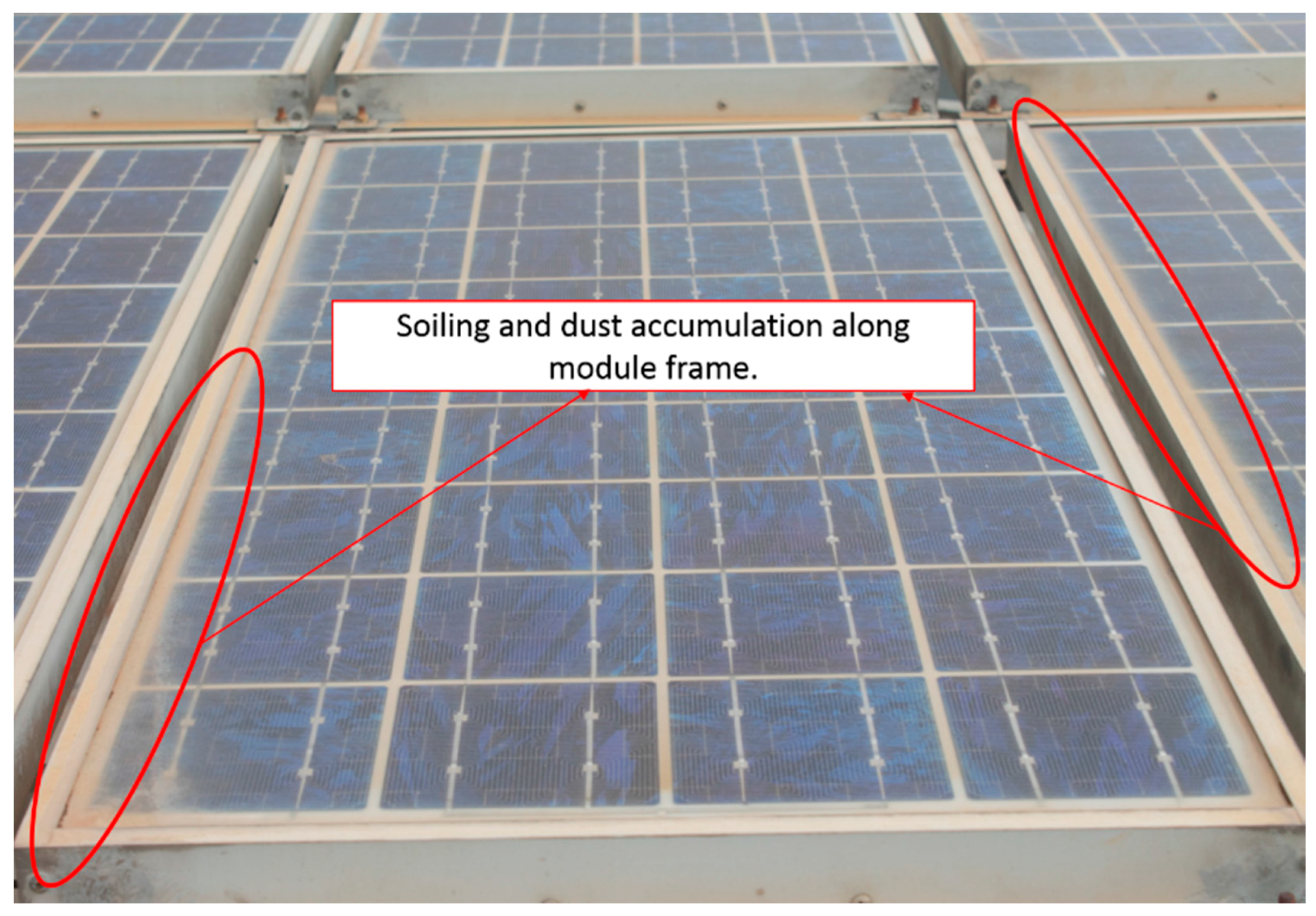
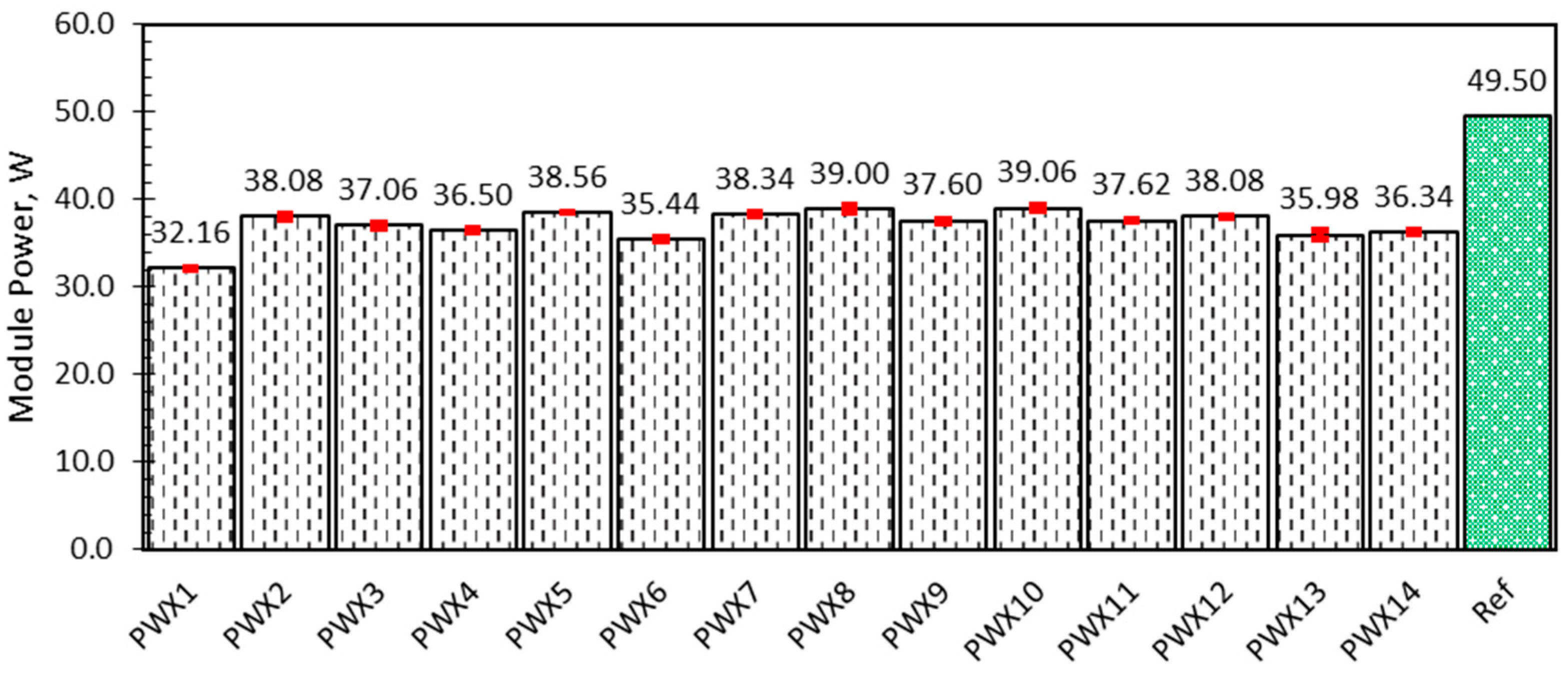
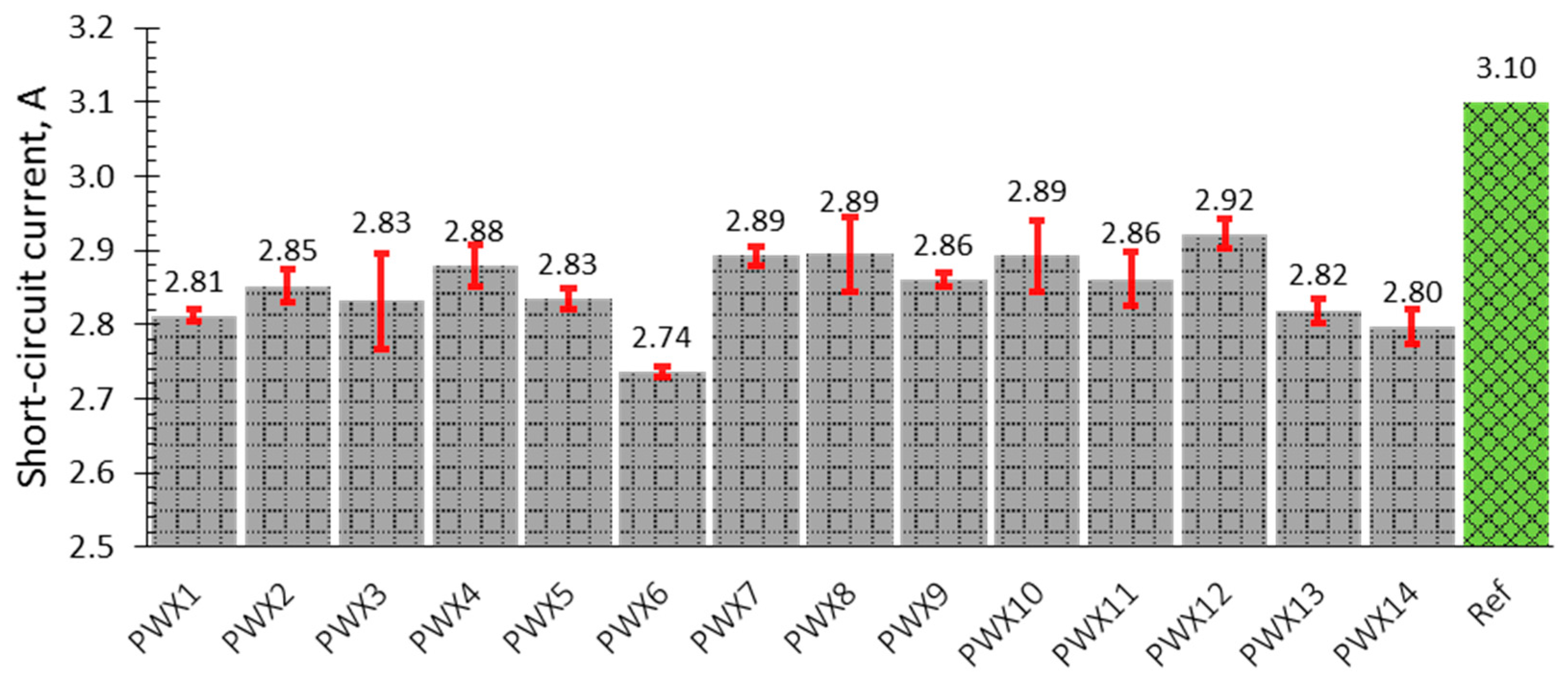
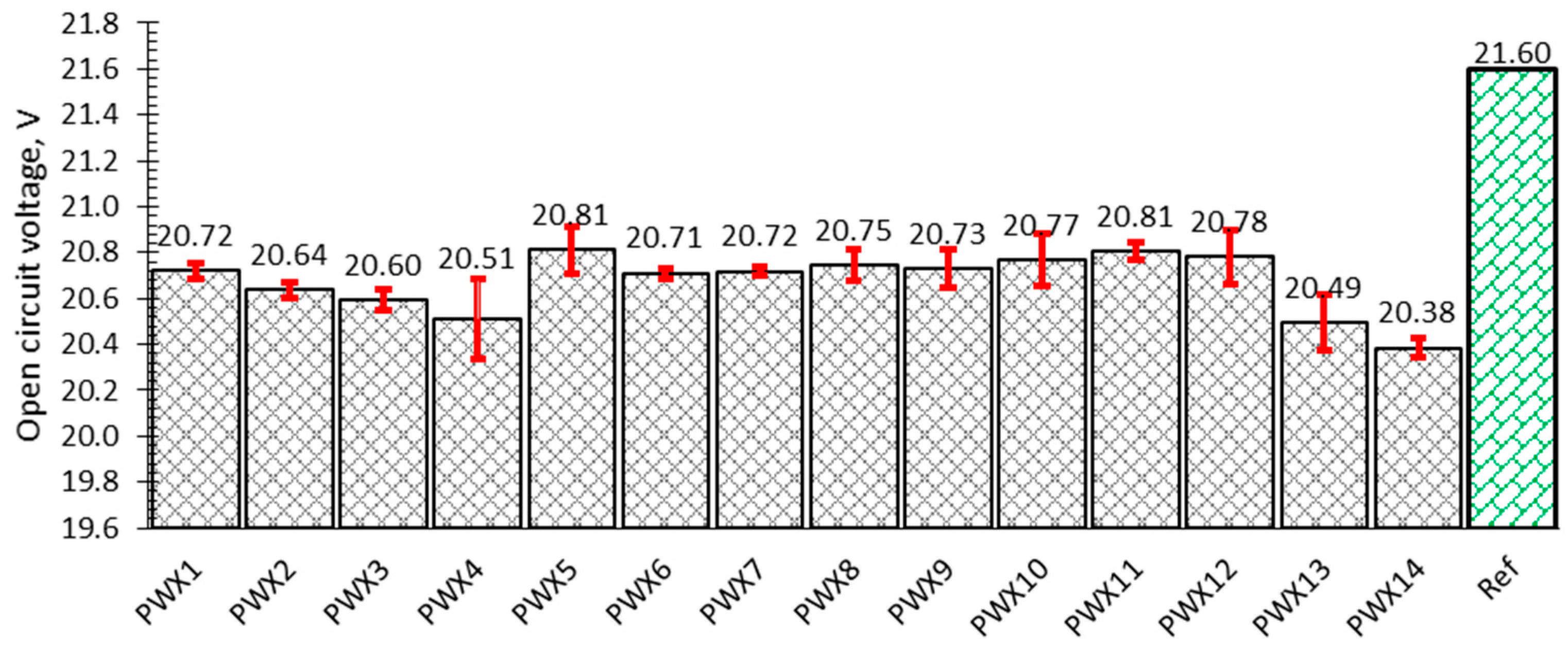


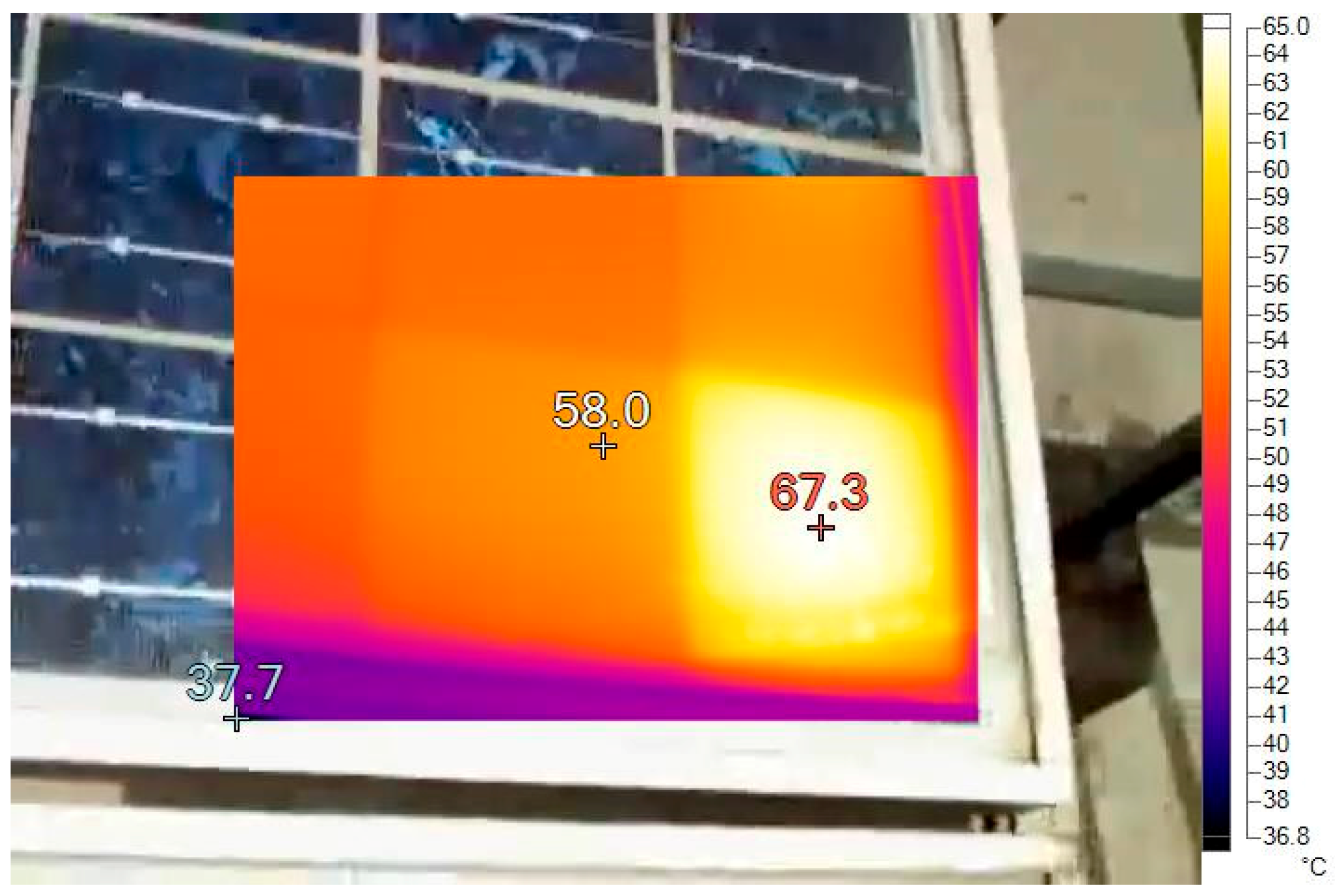
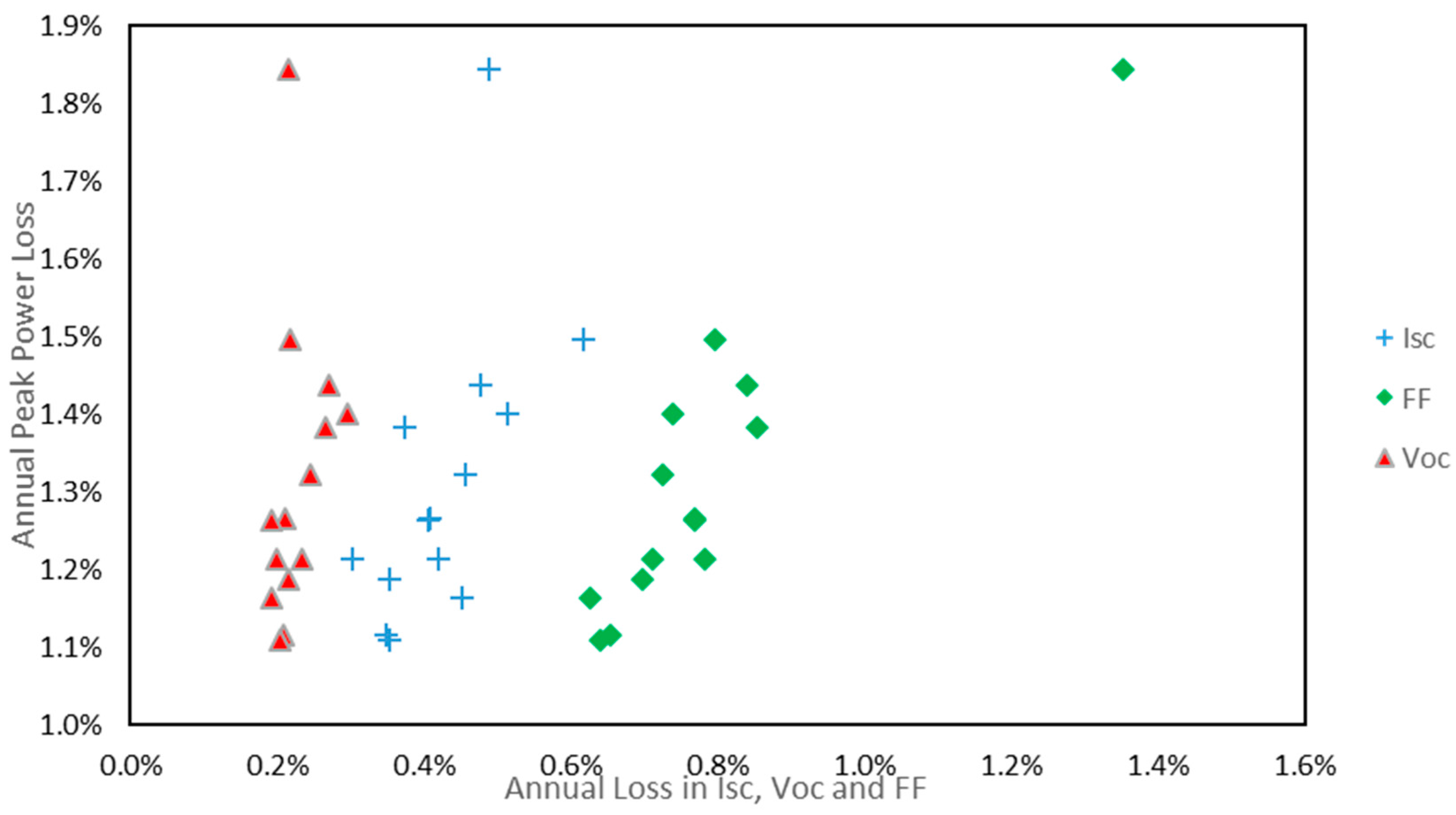
| Parameter | Value |
|---|---|
| Nominal Power (Pnom), W | 49.50 |
| Short-circuit current (Isc), A | 3.10 |
| Open-circuit voltage (Voc), V | 21.60 |
| Current at maximum power point (Impp), A | 2.85 |
| Voltage at maximum power point (Vmpp), V | 17.40 |
| Efficiency | 10.3% |
| Component | Observation(s) |
|---|---|
| Front Glass | Front glass was smooth and dusty prior to cleaning with water; no damage or cracks were observed. Minor occurrence of bubbles were observable on the front side of the module (Figure 8). |
| Backsheet | Minor discoloration observable from front glass (Figure 8)—this might be due to moisture ingress. Generally was like new. No wavy texture was observed, no chalking, burn marks or other damage was visible. |
| Wires/Connectors | no embrittlement or burns was observed. |
| Junction Box | Intact and well-attached, no loss of adhesion was observed, Figure 9 (opened by authors during study). |
| Frame | Minor discoloration was observed; no corrosion was found; frame adhesive was not visible and showed no signs of degradation; the bottom section of the frame was soiled and had accumulated over the years. Figure 10 |
| Metallization | Bus-bars and cell interconnects showed no burns, discoloration or corrosion. Figure 10 |
| PV Cell | The cells were observed to be in good condition. Light discolouration (<5%) could be seen at the edge of some of the cells when the image is magnified. |
| Coefficients | Standard Error | t Stat | p-value | |
|---|---|---|---|---|
| Intercept | 0.002495398 | 0.000502317 | 4.96778 | 4.24 × 10−4 |
| Isc | 0.907725217 | 0.106155361 | 8.55091 | 3.45 × 10−6 |
| FF | 0.869416269 | 0.050343898 | 17.26955 | 2.56 × 10−9 |
| Adjusted R Square: 0.975; F statistic: 256.2 Standard error: 0.000308; | ||||
© 2017 by the authors. Licensee MDPI, Basel, Switzerland. This article is an open access article distributed under the terms and conditions of the Creative Commons Attribution (CC BY) license (http://creativecommons.org/licenses/by/4.0/).
Share and Cite
Quansah, D.A.; Adaramola, M.S.; Takyi, G.; Edwin, I.A. Reliability and Degradation of Solar PV Modules—Case Study of 19-Year-Old Polycrystalline Modules in Ghana. Technologies 2017, 5, 22. https://doi.org/10.3390/technologies5020022
Quansah DA, Adaramola MS, Takyi G, Edwin IA. Reliability and Degradation of Solar PV Modules—Case Study of 19-Year-Old Polycrystalline Modules in Ghana. Technologies. 2017; 5(2):22. https://doi.org/10.3390/technologies5020022
Chicago/Turabian StyleQuansah, David A., Muyiwa S. Adaramola, Gabriel Takyi, and Isaac A. Edwin. 2017. "Reliability and Degradation of Solar PV Modules—Case Study of 19-Year-Old Polycrystalline Modules in Ghana" Technologies 5, no. 2: 22. https://doi.org/10.3390/technologies5020022
APA StyleQuansah, D. A., Adaramola, M. S., Takyi, G., & Edwin, I. A. (2017). Reliability and Degradation of Solar PV Modules—Case Study of 19-Year-Old Polycrystalline Modules in Ghana. Technologies, 5(2), 22. https://doi.org/10.3390/technologies5020022





